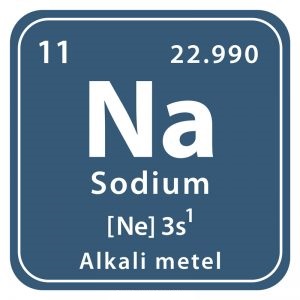Sodium is a chemical element with the symbol Na and atomic number 11. It is a soft, silvery-white metal that is highly reactive and belongs to the alkali metal group of elements. Sodium is the sixth most abundant element in the Earth’s crust, and it is found in a variety of minerals and compounds such as halite (rock salt), soda ash (sodium carbonate), and sodium nitrate.

Physical properties of sodium
Sodium is a soft, silvery-white metal that has a low melting point of 97.8°C (208°F) and a boiling point of 883°C (1621°F). It is highly reactive and has a low density of 0.97 g/cm³, making it less dense than water.
Sodium is a good conductor of electricity and heat, and it is also highly malleable and ductile. It can easily be cut with a knife, and can be formed into various shapes and sizes.
Sodium has a low ionization energy, which means that it readily loses its outermost electron to form a positively charged ion. When exposed to air or water, it quickly oxidizes, forming a layer of sodium oxide or sodium hydroxide on its surface.
Sodium is highly reactive with other elements, particularly with halogens such as chlorine and fluorine. When sodium reacts with these elements, it can release a significant amount of energy, which can be dangerous if not handled properly.
In summary, some of the key physical properties of sodium include its soft, silvery-white appearance, low melting and boiling points, low density, malleability, ductility, and high reactivity with other elements.
Сhemical properties of sodium
Sodium is a highly reactive element with a single valence electron in its outermost shell. As a result, it has several important chemical properties, including:
- Reactivity with water: Sodium reacts vigorously with water, producing hydrogen gas and sodium hydroxide. This reaction is highly exothermic and can produce enough heat to ignite the hydrogen gas.
- Reactivity with oxygen: Sodium reacts with oxygen in the air, forming a layer of sodium oxide on its surface. This layer is highly reactive and can react with water to form sodium hydroxide.
- Reactivity with halogens: Sodium reacts readily with halogens such as chlorine and fluorine to form ionic compounds.
- Reducing agent: Sodium is a powerful reducing agent and can be used to reduce other compounds. For example, it can reduce iron oxide to produce iron metal.
- Alkali metal properties: Sodium is a member of the alkali metal group, which means it has similar chemical properties to other alkali metals such as lithium and potassium. Alkali metals are highly reactive, easily forming ionic compounds with nonmetals.
- Flame coloration: When sodium is burned, it produces a bright yellow flame, which is used in flame tests to identify the presence of sodium ions in compounds.
In summary, sodium is a highly reactive element with a strong tendency to form ionic compounds. Its chemical properties are largely influenced by its single valence electron and membership in the alkali metal group.
Isotopes of sodium
Sodium has 11 protons in its nucleus, which determines its identity as an element. However, the number of neutrons in the nucleus of a sodium atom can vary, resulting in different isotopes of sodium. The three naturally occurring isotopes of sodium are:
- Sodium-23 (Na-23): This is the most common isotope of sodium, accounting for over 95% of all naturally occurring sodium. It has 11 protons and 12 neutrons in its nucleus.
- Sodium-24 (Na-24): This is a radioactive isotope of sodium with a half-life of 15 hours. It has 11 protons and 13 neutrons in its nucleus and is used in nuclear medicine and radiography.
- Sodium-22 (Na-22): This is another radioactive isotope of sodium with a half-life of 2.6 years. It has 11 protons and 11 neutrons in its nucleus and is used in medical research and as a tracer in industry.
There are also several artificial isotopes of sodium that have been produced through nuclear reactions, including Sodium-20, Sodium-21, Sodium-25, and Sodium-26.
These isotopes have varying numbers of neutrons in their nuclei and are typically used in scientific research or nuclear medicine applications.
Use of sodium
Sodium has numerous important applications, including its use as a salt in food and cooking, as a coolant in nuclear reactors, and in the production of various chemicals such as sodium hydroxide and sodium bicarbonate.
It is also used in the production of metal alloys, such as NaK (sodium-potassium alloy), which has unique properties that make it useful in aerospace and nuclear applications.
